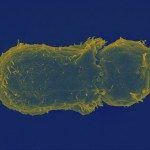Link to Pubmed [PMID] – 8420975
J. Biol. Chem. 1993 Jan;268(3):2013-20
We expressed soluble forms of the human T-cell coreceptor CD8 alpha extracellular region, CD8 alpha 161, and the amino-terminal immunoglobulin-like domain, CD8 alpha 114, in Chinese hamster ovary cells and Escherichia coli, respectively. Both molecules were readily purified to homogeneity in milligram amounts and were recognized by a large panel of monoclonal antibodies. Sodium dodecyl sulfate-polyacrylamide gel electrophoresis analysis indicated that approximately 70% of CD8 alpha 161 was secreted as a disulfide-linked dimer, but CD8 alpha 114 was not disulfide-linked. To investigate the structural features of CD8 alpha 161 and CD8 alpha 114 under native conditions, we performed gel filtration and sucrose gradient sedimentation analysis. In spite of being partially or totally noncovalently bound, both recombinant molecules were stably associated homodimers, as no monomers could be detected at a fairly low protein concentration (approximately 1 microM). This suggests that the CD8 alpha amino-terminal domain alone strongly contributes to chain association. Determination of the Stokes radius (Rs) and sedimentation coefficient (s20,w) gave results consistent with CD8 alpha 114 having a globular shape and CD8 alpha 161 being an asymmetric molecule. Taking into account the contribution of hydration to the frictional coefficient, we obtained for CD8 alpha 161 an axial ratio of approximately 5, when modeled as a prolate ellipsoid. These results indicate that the elongated structure of CD8 alpha 161 is essentially contributed by the hinge region and help to explain how the CD8 alpha is able to bridge the distance between the T-cell surface and its binding site in the alpha 3 domain of major histocompatibility complex class I molecules on the target cell.

